This Fleeting World
This Fleeting World
This Fleeting World
You also want an ePaper? Increase the reach of your titles
YUMPU automatically turns print PDFs into web optimized ePapers that Google loves.
xiv Preface<br />
down even more, teachers could plan to have students look more closely at<br />
the effects of industrialization on particular colonies, such as India, or on<br />
gendered or class relationships within and across societies. Then, teachers<br />
could have students return to the big picture to reconsider it after having<br />
seen industrialism in and across regions.<br />
For Creating Course and Unit Designs<br />
Not only does <strong>This</strong> <strong>Fleeting</strong> <strong>World</strong> help teachers construct a vertical view<br />
of world history through the technique of nested temporal-spatial scales,<br />
the essay also helps teachers develop a linear view of big changes over time.<br />
Thus, teachers might use the chronological and topical divisions in <strong>This</strong><br />
<strong>Fleeting</strong> <strong>World</strong> to frame periodization and topical schemes for their courses.<br />
Throughout each chapter, Christian makes strong arguments for significant<br />
turning points in human history that teachers might use as logical breaks in<br />
instructional time (e.g., units or ends of terms). Teachers might also look to<br />
<strong>This</strong> <strong>Fleeting</strong> <strong>World</strong> for important global topics, such as “The Earliest Cities”<br />
or “Creation of Global Networks,” to frame instructional units or shape<br />
assessments. The descriptions Christian provides of early cities or global<br />
networks can help teachers think about the big and lasting ideas students<br />
could develop from investigating these topics and may spark ideas for the<br />
details a unit of study on early cities or global network might include.<br />
For Stimulating Students’ Thinking<br />
Many teachers will want to use <strong>This</strong> <strong>Fleeting</strong> <strong>World</strong> itself with their students,<br />
and we think that is a very good idea. Students also need big pictures<br />
of the history they study, and so teachers might use <strong>This</strong> <strong>Fleeting</strong> <strong>World</strong><br />
with their students just as we have been using it with teachers—to build a<br />
large-scale picture of the human story. We can think of many good reasons<br />
why teachers might want to use this book in some form or another with<br />
students at the outset of a course, revisiting sections of it at the beginnings<br />
and ends of eras and units. Doing so should help students attach the details<br />
of what they learn to a larger frame, which in turn will help them remember<br />
historical details and make those details them meaningful.<br />
We also think teachers might use sections of the book to provoke<br />
student thinking, stimulate investigations, and encourage critical thinking<br />
about the use of history. For example, the section entitled “Coca-Cola<br />
Culture and the Backlash” is a succinct discussion of the growing global


